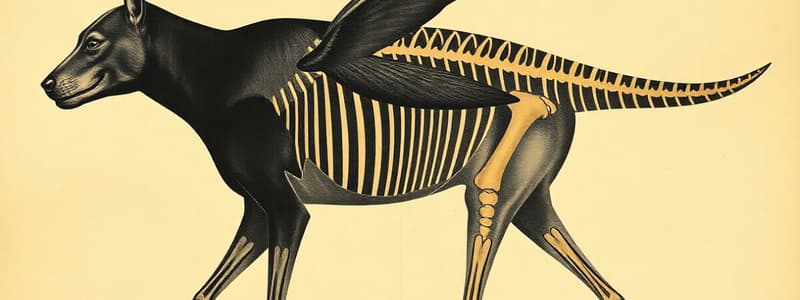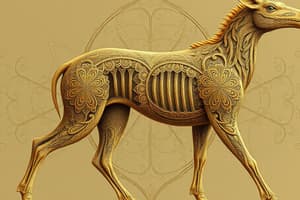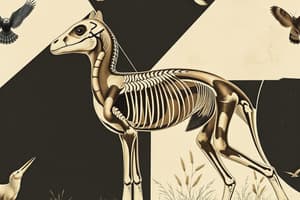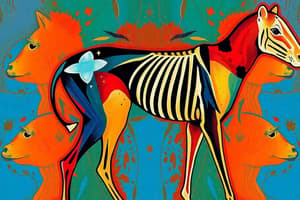Podcast
Questions and Answers
Which of the following is a characteristic of bilaterally symmetrical animals?
Which of the following is a characteristic of bilaterally symmetrical animals?
- Their bodies lack true tissues.
- They have a distinct head region, often containing sensory organs and a brain. (correct)
- They possess a pseudocoelom.
- Their bodies are organized around a central axis with radiating parts.
Which of the following accurately describes the difference between a coelom and a pseudocoelom?
Which of the following accurately describes the difference between a coelom and a pseudocoelom?
- A coelom is partially lined with tissue, while a pseudocoelom is fully lined.
- A coelom provides structural support, while a pseudocoelom is fluid-filled for nutrient transport.
- There is no functional difference; the terms are interchangeable.
- A coelom is fully lined with tissue, while a pseudocoelom is only partially lined. (correct)
Flatworms lack a coelom, resulting in what structural consequence?
Flatworms lack a coelom, resulting in what structural consequence?
- They have specialized tissues for secreting a coelomic fluid.
- Their organs are directly attached to the body tissues. (correct)
- Their organs are loosely suspended within a fluid-filled cavity.
- They possess a rigid, exoskeletal structure.
How are protostomes and deuterostomes differentiated during embryonic development?
How are protostomes and deuterostomes differentiated during embryonic development?
Which term describes the underside, or belly, of an animal?
Which term describes the underside, or belly, of an animal?
In animal anatomy, what is the opposite end of the anterior?
In animal anatomy, what is the opposite end of the anterior?
If a marine biologist is studying the back of a dolphin, which anatomical term would they use to describe that region?
If a marine biologist is studying the back of a dolphin, which anatomical term would they use to describe that region?
Why are animal body plans important for understanding evolutionary and developmental biology?
Why are animal body plans important for understanding evolutionary and developmental biology?
Which of the following is a primary characteristic of animal body plans rather than appearance?
Which of the following is a primary characteristic of animal body plans rather than appearance?
How does radial symmetry benefit animals such as sea jellies in their natural habitat?
How does radial symmetry benefit animals such as sea jellies in their natural habitat?
Which type of symmetry is associated with highly mobile animals that can inhabit both land and aquatic environments?
Which type of symmetry is associated with highly mobile animals that can inhabit both land and aquatic environments?
How does asymmetry in animals like adult flounders relate to their life cycle and adaptation?
How does asymmetry in animals like adult flounders relate to their life cycle and adaptation?
Which of the following features is considered a key component in determining an animal’s body plan?
Which of the following features is considered a key component in determining an animal’s body plan?
Which of the following scenarios best illustrates why animals with different appearances can share the same body plan?
Which of the following scenarios best illustrates why animals with different appearances can share the same body plan?
What evolutionary event is believed to have preceded the emergence of most animal body plans?
What evolutionary event is believed to have preceded the emergence of most animal body plans?
Flashcards
Bilateral Symmetry
Bilateral Symmetry
Having two halves that are mirror images of each other.
Coelom
Coelom
A true body cavity that allows organ growth separate from body tissue.
Coelomates
Coelomates
Animals with a true body cavity.
Pseudocoelom
Pseudocoelom
Signup and view all the flashcards
True Tissues
True Tissues
Signup and view all the flashcards
Protostomes
Protostomes
Signup and view all the flashcards
Anterior
Anterior
Signup and view all the flashcards
Animal Body Plan
Animal Body Plan
Signup and view all the flashcards
Features of Body Plans
Features of Body Plans
Signup and view all the flashcards
Body Symmetry
Body Symmetry
Signup and view all the flashcards
Asymmetry
Asymmetry
Signup and view all the flashcards
Radial Symmetry
Radial Symmetry
Signup and view all the flashcards
Radial symmetry
Radial symmetry
Signup and view all the flashcards
Study Notes
- An animal body plan encompasses the organization of body parts, segmentation, symmetry, limb disposition, and tissue structure
- Animals may share a body plan without sharing the same appearance
- Body plans classify anatomical structures, not appearances
Evolution and Significance
- Most animal body plans emerged after the Cambrian Explosion (542 million years ago)
- Adaptations evolve within body plans for environmental survival
- Body plans are crucial for understanding evolutionary and developmental biology and animal classification
Features of Animal Body Plans
- Body plans are defined by anatomical features, including body symmetry types, body cavities, tissues, and segmentation patterns
- Shared features indicate a shared body plan, regardless of appearance
Body Symmetry in Animals
- Body symmetry compares an animal's body halves
- Three common types of body symmetry include asymmetry, radial symmetry, and bilateral symmetry
Asymmetry
- Asymmetry, the absence of symmetry, is mainly in sponges (phylum Porifera)
- Symmetry can change during an animal's life cycle as seen in the asymmetry of adult flounders
Radial Symmetry
- Radial symmetry means the animal looks the same from the center in all directions
- Halves are identical regardless of the slice direction
- Radial symmetry is common in sedentary, often aquatic animals like sea jellies and coral
Bilateral Symmetry
- Bilateral symmetry divides an animal into two mirror-image halves
- Bilaterally symmetrical animals tend to be mobile animals
- These animals often have sensory organs and a brain located in the head
- Humans and mammals exhibit bilateral symmetry
Structures in Animal Body Plans
-
Key structures include body cavities, tissues, and the mouth
-
Animals possessing a coelom have an actual body cavity, which facilitates organ growth while also keeping organs separate from the body tissue
-
Organs in animals lacking a coelom directly attach to the body tissues
-
Most bilaterally symmetrical animals possess a coelom
-
A pseudocoelom is similar to a coelom but lacks tissue lining the entire body cavity, as seen in roundworms
-
Flatworms lack a coelom or pseudocoelom
-
Eumetazoans have true tissues with specialized cells for specific tasks
-
Protostomes develop the mouth before the anus during embryonic development
-
Deuterostomes develop the anus before the mouth during embryonic development
-
Humans are deuterostomes
Location of Structures in Animal Body Plans
- Specific terms replace directional words to accurately describe body part locations
- The anterior part of the animal is the head
- The posterior is the opposite end from the anterior
- The dorsal side is the backside of the animal
- The ventral side is the bottom of the animal
Studying That Suits You
Use AI to generate personalized quizzes and flashcards to suit your learning preferences.




